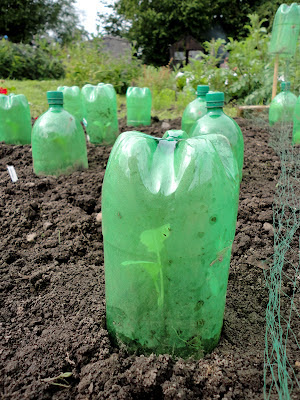The king of vegetables
I've been gardening on the allotment for three years now, and I've been relatively successful with most things I've grown - well, most things that can successfully be grown in England, that is. I've had very little success with aubergines, but I should probably just give up and accept that I don't live in Italy.
The one main exception is the brassicas. These include many of my favourite vegetables - broccoli, cauliflower, romanesco, kale, brussels sprouts. And then there are the Asian versions: bok choi, napa cabbage, choi sum, nabana. We are told these are superfoods: nutritious, high in dietary fiber, low in calories, and tasty to boot. Unfortunately, garden pests are all too aware of these benefits as well.
My first year I tried to grow bok choi. The plants were growing beautifully, and had reached about five inches in height, when I went down one day to find the row completely stripped bare. This was how I learned how essential netting is to prevent the wood pigeons from eating my cabbage down to the ground.
 |
| Veggie-related bunting at the allotment - the pigeons like peas as well |
Once your cabbage are a bit larger and less tender, birds are no longer quite as interested. This is when you have to start looking out for smaller pests, including whitefly. These are tiny white moths that will infest the leaves and weaken the plants, retarding growth. I try to keep on top of them by spraying frequently with soap solution. I had a terrible time with them in previous years, but this year I haven't seen any. Maybe they don't like the rain.
Another pest that you have to watch out for is cabbage white butterflies. They lay their eggs on the underside of the cabbage leaves, and the developing caterpillar will munch its way through whole leaves. I haven't had as much trouble with these - possibly because the netting deters them to a certain extent. Any that get through, you just need to try to destroy the eggs and pick off the caterpillars.
Allotment gardening is a continuous learning process. My worst pest this year, flea beetles, didn't even show up until year 2. And now the garden is infested with them. They are tiny little black beetles that chew numerous holes in cabbage leaves, until it looks like lace. Naturally, this inhibits growth, but also makes the leaves dry, leathery, and pretty inedible. I haven't found a way to manage them, other than by covering the plants with cloches. If I spray them with soap solution they just seem to hop off the leaves and come back for more later.
 |
| Pesky flea beetles |
And this year, because of the constant rain, we have been inundated with slugs and snails. I have given up on organic gardening and now scatter slug pellets with abandon. It is so satisfying to see the resultant exploded slugs. And although the manufacturers promise they do not attract other animals, I must confess I would not mind if I poisoned a few pigeons on the side!
 |
| Hate the slugs, but I have a soft spot for snails. |
I usually sow my seeds out directly in the garden, because I only have a small greenhouse on my balcony which is reserved for especially delicate plants like tomatoes and gherkins. Cabbage are relatively hardy and can handle cooler temperatures. But if the pests get to them when they are tender seedlings they don't have much of a chance. I had such poor results in previous years I almost gave up - but I decided to make one final effort, and ordered seedlings in the post.
 |
| 3 types of romanesco and 3 types of kale |
I felt a bit of a cheat until I read in Tender, Nigel Slater's cooking and gardening book, that he does the same. If the professionals do it, why not me?
I cover the seedlings with half-bottle cloches until they outgrow them.
 |
| romanesco and kale planted out |
And then cover with netting.
 |
| white cabbage and brussels sprout planted earlier in the year |
In general it has been a terrible year for gardening, but so far it looks to be a good year for cabbage, so I'm glad I gave them one more chance. They are thriving with all the rain, and don't seem to mind the fact that light levels in June were more consistent with February.
And the best thing about cabbages - they'll be ready to eat in the middle of winter when gardening on the allotment (even in this poor excuse of a summer) is a distant, fond memory.

No comments:
Post a Comment